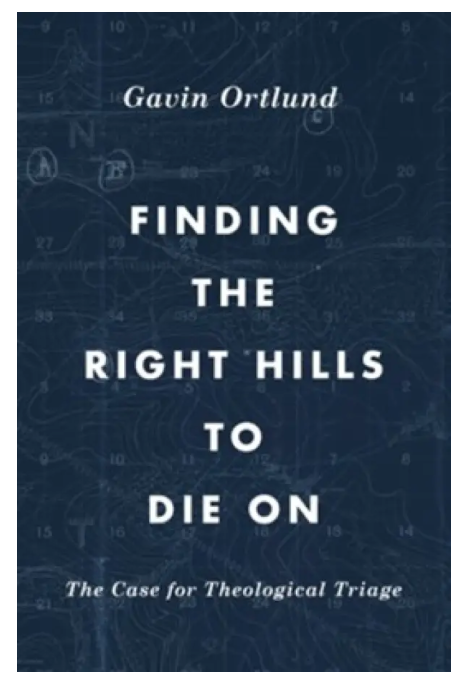This post contains affiliate links
Finding the Right Hills to Die On is one of pastor Gavin Ortlund’s recent releases. I first learned about this book via Instagram and the title intrigued me. I read the book’s description and felt that it would be a fitting read considering that the time and culture in which we live is rife with division even, sadly, amongst Christians.
Ortlund uses the term theological triage to help his audience understand how to prioritize doctrinal matters like the Bible does. The term theological triage is adapted from the medical field to help Christians understand the varying degrees of importance doctrinal issues possess. Ortlund contends that the goal of theological triage is primarily to please Christ.
Regarding this, he explained, “. . . the dire needs of the time require us to make strategic decisions of prioritization in order to be as effective as possible at pleasing Christ, serving the church, and advancing his gospel,” (pg. 18). This was a helpful reminder because it often seems that many doctrinal disagreements lead to ungodliness because those participating in them have lost sight of why doctrine matters.
A part of pleasing Christ is maintaining the unity of the body of believers that churches are composed of. Ortlund maintains that “Our unity is so important that Jesus gave his blood for it,” (pg. 34). In Finding the Right Hills to Die On, he helps readers understand this by including categories for theological triage on page 19. These categories are:
- First-rank doctrines are essential to the gospel itself.
- Second-rank doctrines are urgent for the health and practice of the church such that they frequently cause Christians to separate at the level of local church, denomination, and/or ministry.
- Third-rank doctrines are important to Christian theology, but not enough to justify separation or division among Christians.
- Fourth-rank doctrines are unimportant to our gospel witness and ministry collaboration.
By providing this list, Ortlund outlines a helpful framework for informing Christians of when it is time to address an issue and how to do so in a way that honors God and exemplifies a love of neighbor. He also makes the important distinction that while an issue may be nonessential when it comes to understanding the gospel, that doesn’t automatically equate to it being unimportant.
Finding the Right Hills to Die On doesn’t tell readers which specific hills to die or (or not die on) but offers useful direction for how to discern which hills are worth dying on. Of more importance, he guides readers into what it would look like to disagree with a brother or sister in Christ in a manner that is humble, gentle, and kind. One extraordinarily helpful insight he shared is that “We must make the distinction between confused sheep and active wolves,” (pg. 81).
Ortlund understands what it is like to work through doctrinal issues in order to cultivate personal convictions because he has done so. Chapter 3 of Finding the Right Hills to Die On is dedicated to his sharing of how he arrived at certain convictions after spending much time working through how the Bible informs them. This chapter was such a testament to me of the humility of Christ as Ortlund outlined how he arrived at some of his personal convictions but was able to do so while humbly maintaining unity with his brother and sisters in Christ.
He dedicated an entire chapter, titled Navigating the Complexity of Secondary Doctrines, to exploring second-rank issues. This chapter was especially fascinating as he examined generally contentious issues including baptism, continuationism vs. cessationism, and women in ministry. Ortlund provided a broad, gracious, objective treatment of each issue. Rather than using these chapters to persuade readers of his convictions on these issues, he used them to help readers understand how these issues are contentious so that they may recognize why and how individuals may arrive at varying doctrinal views and remain Christians.
In addressing baptism on pages 107-108, he includes a list of compelling questions to help readers cultivate their own convictions on the matter. Although referring specifically to baptism, I really enjoyed these questions and find them to be helpful for arriving at convictions on a variety of issues, doctrinal and otherwise. These questions are:
- Is there anything in my heart that takes pride in my view or feels superior to Christians who are on “the other side”? If so, how can I direct my heart back to the gospel as the only source of my identity and “rightness”?
- Is there anything in me that is disrespectful or dismissive of the importance of this issue?. . . Do I feel superior to or exasperated with, those Christians who elevate this issue more highly than I do? How can I better understand their concerns and thereby move toward them?
- Have I taken seriously the urgency of Christ’s prayer for the unity of the church (John 17), and am I looking to take whatever steps I can to pursue the realization of this prayer in my own life?
- What is the right context for me to flourish both in maintaining my own convictions. . . and in pursuing genuine fellowship and partnership in the gospel with those who differ?
Ortlund offers a convicting clarion call for Christians everywhere to cultivate and maintain unity with each other as a means of pointing to the unity that God has secured for them in Christ. He wrote, “We should go out of our way to show charity toward Christians who hold to a different view than we do, and seek to learn from them. They are part of the body of Christ and, therefore, a part of that people with whom we must have unity in order to make the gospel credible before a watching world (John 17:21). We should look for opportunities to link arms and promote the gospel, wherever we can,” (pg. 106-107).
Finding the Right Hills to Die On concludes with an encouragement for Christians to cultivate humility and allow that to be the foundation for doctrinal disagreements. Fittingly so as Ortlund’s humility and love for others, ultimately reflected in his love for Christ, permeates every page. From a book that one might expect is going to be more academic in style and content, I found myself greatly encouraged and eager to cultivate the godly characteristics that are necessary for maintaining the unity of the Spirit in the bond of peace.
I really enjoyed Finding the Right Hills to Die On and highly recommend it and I look forward to reading more from Gavin Ortlund in the future.
For Further Reading
Theological Triage in the 21st Century
20 Quotes on How (and When) to Fight Over Doctrine
What Theological Hills Should We Be Willing to Die On?











